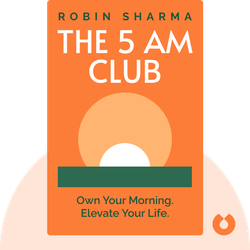Try Blinkist to get the key ideas from 7,000+ bestselling nonfiction titles and podcasts. Listen or read in just 15 minutes.
Start your free trial
Blink 3 of 8 - The 5 AM Club
by Robin Sharma

Raising Healthy Kids in a Culture of Dependence
The Addiction Inoculation by Jessica Lahey is a parenting guide on preventing and treating addiction in children. It offers evidence-based methods for fostering resilience, emotional regulation, and healthy coping mechanisms.
Being a teenager is both intense and confusing. On the one hand, your teenage years are profoundly exciting and memorable. On the other, many teens find themselves dealing with troubling new experiences and unfamiliar emotions.
All the while, you're doing your best to fit into a shifting social landscape – learning that what was cool last year might be cringeworthy the next.
What many people don't realize is that the uniqueness of your teenage years isn’t just down to novel experiences, like first love, going to prom, or learning to drive. There are brass-tack issues of cognitive development at play – factors that also make the teenage brain far more vulnerable to substance abuse.
This is the key message: Substance use is both more attractive and more damaging to teenagers.
The structures in the brain known as the frontal and prefrontal cortexes can explain some of the key differences between teenagers and fully-grown adults. You see, these regions play a key role in setting goals, planning, and strategizing.
By your mid-twenties, they should be fully functioning – but in adolescence, they’re still largely undeveloped.
So, if you have teenagers whose behavior makes you want to pull your hair out, this is likely why. Their decisions are less likely to involve more logical and strategic parts of the brain, parts that we adults often rely on. Instead, they’re driven by the limbic system, a collection of structures that process emotions, instincts, memories, and desires.
In unscientific terms, this can make teenagers do incredibly stupid shit. Their impulsivity and risky behavior make substance use more likely – and the immaturity of the teenage brain also means that substance use does far greater harm.
Abusing substances in your mid-twenties is still a really bad idea, sure – but people who use alcohol and drugs when their brains are fully formed are much less likely to experience the poor mental health and cognitive issues that plague teenage users.
So, how can you keep risk-taking teens away from drinking and drugs altogether? The first step is to understand the risk factors that make substance use more likely.



The Addiction Inoculation (2021) is a parents’ guide to raising kids who have the knowledge, support, and self-confidence necessary to steer clear of the twin dangers of alcohol and drug use. From peer pressure to self-efficacy, it examines the risks kids need to avoid, and the defenses they need to acquire, in order to live happy, healthy, and substance-free lives.
The Addiction Inoculation (2021) explores the science behind addiction and offers practical tools to prevent substance abuse in children. Here's why this book is worth reading:
It's highly addictive to get core insights on personally relevant topics without repetition or triviality. Added to that the apps ability to suggest kindred interests opens up a foundation of knowledge.
Great app. Good selection of book summaries you can read or listen to while commuting. Instead of scrolling through your social media news feed, this is a much better way to spend your spare time in my opinion.
Life changing. The concept of being able to grasp a book's main point in such a short time truly opens multiple opportunities to grow every area of your life at a faster rate.
Great app. Addicting. Perfect for wait times, morning coffee, evening before bed. Extremely well written, thorough, easy to use.
Try Blinkist to get the key ideas from 7,000+ bestselling nonfiction titles and podcasts. Listen or read in just 15 minutes.
Start your free trial
Blink 3 of 8 - The 5 AM Club
by Robin Sharma
What is the main message of The Addiction Inoculation?
The main message of The Addiction Inoculation is understanding how to prevent addiction in children.
How long does it take to read The Addiction Inoculation?
The reading time for The Addiction Inoculation varies, but the Blinkist summary can be read in just 15 minutes.
Is The Addiction Inoculation a good book? Is it worth reading?
The Addiction Inoculation is a valuable read as it provides insights on preventing addiction in children and helps parents make informed decisions.
Who is the author of The Addiction Inoculation?
Jessica Lahey is the author of The Addiction Inoculation.